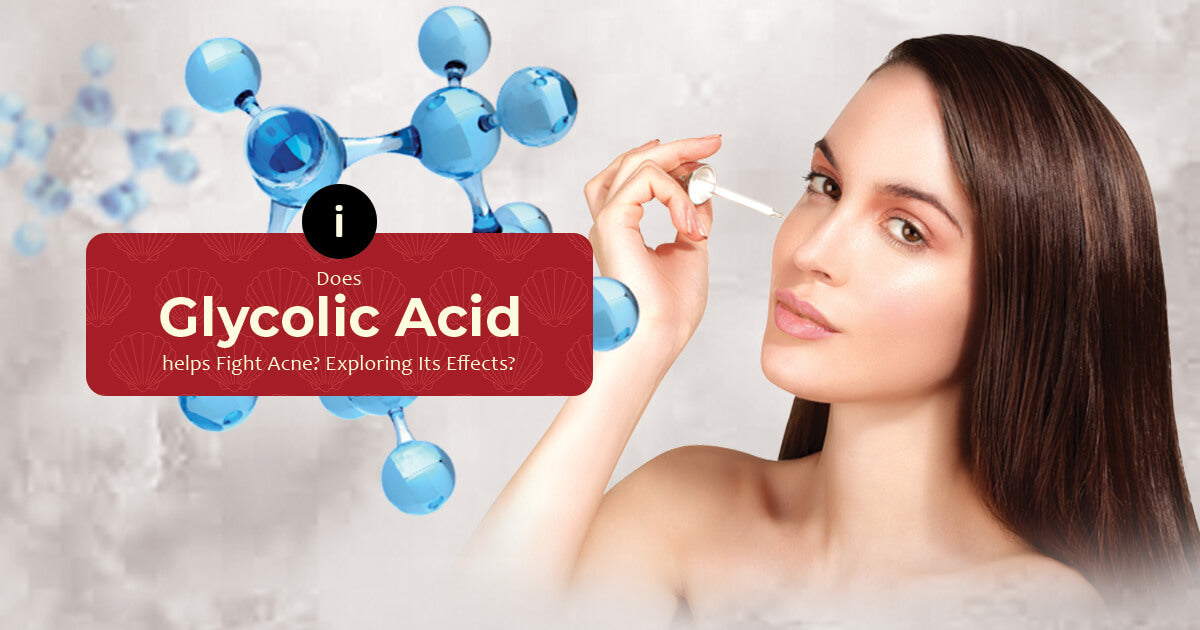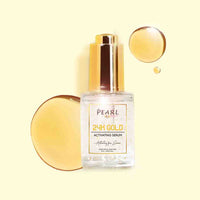Glycolic acid, a tiny molecule, is a type of alpha hydroxy acid (AHA) produced from sugarcane. This matter doesn’t have any taste or smell, which is also one of the reasons it is used highly in the skincare industry, besides its benefits. Many say this crystalline solid effectively treats hyperpigmentation and helps exfoliate the skin. Is it true, though? Does Glycolic acid helps in reducing acne? In this blog post, we are about to find out its benefits and effects on sensitive skin types, as well as the precautions to follow before using it.

Benefits of Glycolic Acid
Acts as a Potent Exfoliant
Glycolic Acid can effectively unclog pores and wash off dead skin cells. This is because it can weaken the bonds between the outermost layer of the skin (including dead skin cells) and the next layer. This helps in the easy wash-off of dead skin cells and helps in proper new skin cell regeneration, which makes the skin look radiant.
Promotes Better Skin Cell Replacement
The outermost layer of the skin usually becomes weak as it sheds its old skin cells. After this process, new cells regenerate, and this layer of skin formed by the new cells makes the skin look shiny and glowy. This whole process is very fast and easy when glycolic acid comes into action. It can also aid in Sun Damage and reduce hyperpigmentation through this skin cell rejuvenation.

Cleansing the Pores
Glycolic acid's exfoliating properties can also help unclog pores. It washes off dirt and dead skin cells, the primary causes of blackheads and whiteheads. By using glycolic acid, acne breakouts can be minimized by keeping our pores clean.
Moisture Retention
Glycolic acid can attract and bind water to the skin cells. This is called the Humectant property. This can help balance the moisture levels in acne-prone skin. This property makes it one of the widely used ingredients in face masks.
Glycolic acid and its effects on Sensitive skin
Even though glycolic acid can benefit all skin types, people with sensitive skin types should exercise caution before using it. This is especially beneficial if the products used are dermatologist-prescribed. It's better if people with sensitive skin types start with lower glycolic acid or other skincare product doses. Sensitive skin can react intensely with glycolic acid, resulting in redness, irritation, and a burning sensation when the skin's outer layer is washed off. Also, many people with sensitive skin types complain about irritations when exposed to the sun when glycolic acid is applied.
Sensitive skin is already very prone to sun sensitivity, and exposure to sun when applying glycolic acid can worsen the effect. So, it is recommended that extra precautions be taken when using glycolic acid in the sun. Before using glycolic acid, people should be aware of the concentrations and the dosage (the amount that must be applied based on their skin type). Overusing glycolic acid can cause over-exfoliation and huge discomfort, making the skin dry, red, and more sensitive.
Precautions for Sensitive Skin Type
To ensure that Glycolic acid is good/bad for the skin, perform a patch test. Apply it only to a small area on the skin and see the results. Always use the product with lower concentrations (10% to 15%) of glycolic acid. If there's no issue, one can gradually increase the concentration. Glycolic acid may have the chance to react with any dirt on the face.
Start by washing the face thoroughly with a mild cleanser before applying a glycolic acid-based product. Start with lower contact time. Apply a glycolic acid-based product for a short period, maybe a few minutes. Wash it off with water after that. If there's no issue, one can slowly extend the contact time for better results.
Moisturize skin with a moisturizer suitable for the skin type. Gradually increase the frequency of application if there are no issues. If there is no issue, then well and good. Be patient. The results won't occur overnight. Every skincare application takes time and consistency.
ARM Pearl Beauty Pigmentation Cream
Pigmentation is an issue faced by people after turning 30. Dark spots appear and pigmentation marks are seen all over the face and neck. To help people resolve the pigmentation, ARM Pearl Beauty has formulated a Skin Brightening and Pigmentation cream to reduce pigmentation and dark spots on our skin surface. It is blended with ingredients Kojic acid, Alpha Arbutin, Hydroquinone and glycolic acid. This face creams for pigmentation on regular usage keeps the skin glowing, with clear texture and erases all pigmentation marks.
Conclusion
Glycolic acid is a versatile skincare ingredient that can address various skin concerns, including acne scars, blackheads, and back acne. When choosing between glycolic acid and salicylic acid for acne, it's important to consider one’s skin type and needs, as both acids offer unique benefits. To maximize the benefits of glycolic acid for acne scars, it's essential to use it consistently and follow proper skincare guidelines.
Frequently Asked Questions about Glycolic Acid
Can glycolic acid remove active acne?
In the process of exfoliation, glycolic acid can wash off the dirt and sebum accumulated in the pores. This penetrative ability makes glycolic acid an excellent ingredient for reducing acne.
How long will my skin be purged from glycolic acid?
To differentiate, purging usually occurs where you typically break out. It aligns with the skin’s cycle and should clear up within 4-6 weeks of starting a new routine, though it may take up to 3 months; anything longer might indicate a reaction.
How long does glycolic acid take to fade acne scars?
It may take up to 12 weeks to see the results. Sometimes, more time is needed, sometimes less. However, it is crucial to be consistent.











